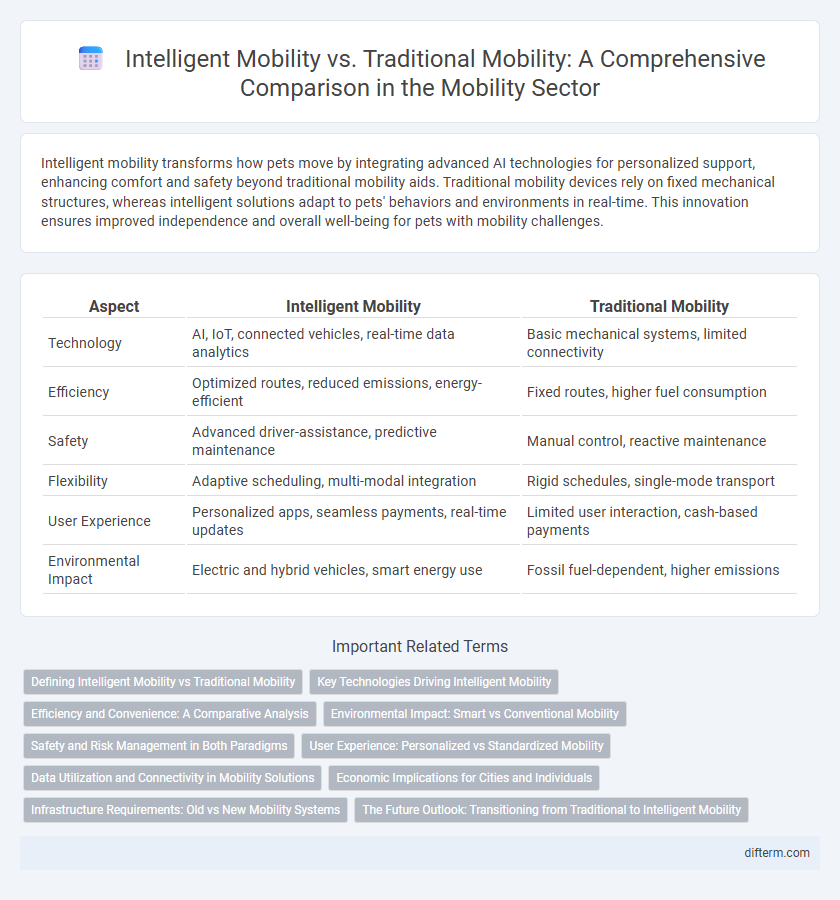Intelligent mobility transforms how pets move by integrating advanced AI technologies for personalized support, enhancing comfort and safety beyond traditional mobility aids. Traditional mobility devices rely on fixed mechanical structures, whereas intelligent solutions adapt to pets' behaviors and environments in real-time. This innovation ensures improved independence and overall well-being for pets with mobility challenges.
Table of Comparison
| Aspect | Intelligent Mobility | Traditional Mobility |
|---|---|---|
| Technology | AI, IoT, connected vehicles, real-time data analytics | Basic mechanical systems, limited connectivity |
| Efficiency | Optimized routes, reduced emissions, energy-efficient | Fixed routes, higher fuel consumption |
| Safety | Advanced driver-assistance, predictive maintenance | Manual control, reactive maintenance |
| Flexibility | Adaptive scheduling, multi-modal integration | Rigid schedules, single-mode transport |
| User Experience | Personalized apps, seamless payments, real-time updates | Limited user interaction, cash-based payments |
| Environmental Impact | Electric and hybrid vehicles, smart energy use | Fossil fuel-dependent, higher emissions |
Defining Intelligent Mobility vs Traditional Mobility
Intelligent mobility integrates advanced technologies such as IoT, AI, and real-time data analytics to optimize transportation efficiency, safety, and environmental impact. Traditional mobility relies on fixed infrastructure and human-driven vehicles with limited connectivity and adaptability. The core difference lies in intelligent mobility's dynamic, interconnected systems enabling predictive management and seamless multimodal travel.
Key Technologies Driving Intelligent Mobility
Key technologies driving intelligent mobility include advanced AI algorithms, Internet of Things (IoT) connectivity, and autonomous vehicle systems that enable real-time data processing and decision-making. Unlike traditional mobility, which relies on fixed infrastructure and human operation, intelligent mobility integrates machine learning and sensor fusion to optimize traffic flow and enhance safety. These innovations reduce congestion, lower emissions, and improve user experience through seamless, adaptive transportation networks.
Efficiency and Convenience: A Comparative Analysis
Intelligent mobility leverages real-time data, AI algorithms, and IoT connectivity to optimize route planning and reduce travel time, significantly enhancing efficiency compared to traditional mobility systems reliant on fixed schedules and static routes. Convenience is greatly improved through seamless integration of multiple transport modes, personalized travel options, and on-demand services, enabling users to tailor their journeys with minimal effort. This contrasts with traditional mobility's limited flexibility and higher dependency on user planning and adherence to rigid infrastructure constraints.
Environmental Impact: Smart vs Conventional Mobility
Intelligent mobility significantly reduces environmental impact through optimized route planning, electric vehicle integration, and real-time traffic management, cutting carbon emissions and pollution. Conventional mobility predominantly relies on fossil fuel-powered vehicles, leading to higher greenhouse gas emissions and contributing substantially to urban air pollution. The shift towards smart mobility solutions is critical for achieving sustainable transportation and mitigating climate change effects.
Safety and Risk Management in Both Paradigms
Intelligent mobility leverages real-time data analytics, advanced sensors, and AI-driven decision-making to significantly enhance safety by predicting hazards and mitigating risks before they occur. Traditional mobility relies heavily on static infrastructure and human intervention, which increases vulnerability to accidents and delayed responses to emerging dangers. Effective risk management in intelligent mobility reduces collision rates and improves emergency response times, setting new standards for transportation safety.
User Experience: Personalized vs Standardized Mobility
Intelligent mobility transforms user experience by offering personalized transportation options tailored to individual preferences, real-time traffic data, and adaptive route planning, enhancing convenience and efficiency. Traditional mobility relies on standardized schedules and fixed routes, often resulting in longer wait times and limited flexibility. Personalized services in intelligent mobility improve satisfaction by dynamically adjusting to user needs, contrasting sharply with the rigid structure of conventional transportation systems.
Data Utilization and Connectivity in Mobility Solutions
Intelligent mobility leverages real-time data analytics and IoT connectivity to optimize traffic flow, reduce congestion, and enhance user experience, contrasting sharply with traditional mobility systems that rely on static schedules and fixed routes. Advanced mobility solutions harness vehicle-to-everything (V2X) communication, enabling seamless interaction between vehicles, infrastructure, and pedestrians for proactive safety and efficiency improvements. Data-driven decision-making in intelligent mobility accelerates adaptive routing and predictive maintenance, significantly outperforming conventional approaches in scalability and responsiveness.
Economic Implications for Cities and Individuals
Intelligent mobility reduces urban congestion and lowers transportation costs by optimizing traffic flow through data-driven solutions, resulting in significant economic benefits for cities. Traditional mobility often incurs higher expenses due to inefficiencies, increased fuel consumption, and longer travel times, burdening both municipal budgets and individual commuters. Investments in intelligent transportation infrastructure can enhance productivity, reduce emissions, and create new economic opportunities in urban centers.
Infrastructure Requirements: Old vs New Mobility Systems
Intelligent mobility demands advanced infrastructure integrating IoT sensors, real-time data processing, and adaptive traffic management systems, contrasting sharply with traditional mobility's reliance on static road designs and fixed traffic signals. New mobility systems require extensive digital connectivity, renewable energy sources for electric vehicles, and smart charging stations, unlike conventional setups focused primarily on fuel stations and basic road maintenance. This evolution in infrastructure supports enhanced efficiency, reduced congestion, and lower environmental impact compared to traditional mobility frameworks.
The Future Outlook: Transitioning from Traditional to Intelligent Mobility
Intelligent mobility integrates advanced technologies such as IoT, AI, and connected vehicles, enabling real-time data analysis for optimized traffic flow and reduced emissions. Traditional mobility relies heavily on fossil fuels and static infrastructure, leading to congestion and environmental challenges. The future outlook highlights a gradual transition where smart transportation networks and autonomous vehicles redefine urban mobility, promoting sustainability and efficiency.
intelligent mobility vs traditional mobility Infographic

 difterm.com
difterm.com